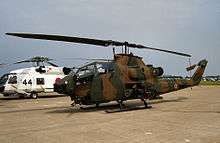Bell AH-1 Cobra
The Bell AH-1 Cobra is a two-blade rotor, single-engine attack helicopter manufactured by Bell Helicopter. It was developed using the engine, transmission and rotor system of the Bell UH-1 Iroquois. A member of the prolific Huey family, the AH-1 is also referred to as the HueyCobra or Snake.
| AH-1 HueyCobra/Cobra | |
|---|---|
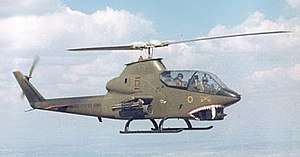 | |
| A Bell AH-1G HueyCobra in flight | |
| Role | Attack helicopter |
| National origin | United States |
| Manufacturer | Bell Helicopter |
| First flight | 7 September 1965 |
| Introduction | 1967 |
| Retired | 2001 (US Army) |
| Status | In service |
| Primary users | United States Army (historical) Japan Ground Self-Defense Force Republic of Korea Army Royal Jordanian Air Force |
| Produced | 1967–2019 |
| Number built | 1,116 |
| Unit cost |
US$11.3 million (1995) (AH-1 HueyCobra)[1] |
| Developed from | Bell UH-1 Iroquois |
| Variants | Bell AH-1 SeaCobra/SuperCobra Bell 309 KingCobra |
The AH-1 was the backbone of the United States Army's attack helicopter fleet, but has been replaced by the AH-64 Apache in Army service. Upgraded versions continue to fly with the militaries of several other nations. The AH-1 twin-engine versions remain in service with United States Marine Corps (USMC) as the service's primary attack helicopter. Surplus AH-1 helicopters have been converted for fighting forest fires.
Development
Background
Closely related to the development of the Bell AH-1 is the story of the Bell UH-1 Iroquois—an icon of the Vietnam War and one of the most numerous helicopter types built. The UH-1 made the theory of air cavalry practical, as the new tactics called for US forces to be highly mobile across a wide area. Unlike before, they would not stand and fight long battles, and they would not stay and hold positions. Instead, the plan was that the troops carried by fleets of UH-1 "Hueys" would range across the country, to fight the enemy at times and places of their own choice.[2]
It soon became clear that the unarmed troop helicopters were vulnerable against ground fire from Viet Cong and North Vietnamese troops, particularly as they came down to drop their troops in a landing zone. Without friendly support from artillery or ground forces, the only way to pacify a landing zone was from the air, preferably with an aircraft that could closely escort the transport helicopters, and loiter over the landing zone as the battle progressed. By 1962 a small number of armed UH-1As were used as escorts, armed with multiple machine guns and rocket mounts.[3]
The massive expansion of American military presence in Vietnam opened a new era of war from the air. The linchpin of US Army tactics was the helicopters, and the protection of those helicopters became a vital role.[4]
Iroquois Warrior, Sioux Scout and AAFSS
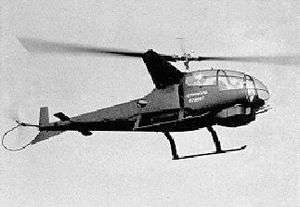
Bell had been investigating helicopter gunships since the late 1950s, and had created a mockup of its D-255 helicopter gunship concept, named "Iroquois Warrior". In June 1962, Bell displayed the mockup to Army officials, hoping to solicit funding for further development. The Iroquois Warrior was planned to be a purpose-built attack aircraft based on UH-1B components with a new, slender airframe and a two-seat, tandem cockpit. It featured a grenade launcher in a ball turret on the nose, a 20 mm belly-mounted gun pod, and stub wings for mounting rockets or SS.10 anti-tank missiles.[5]
The Army was interested and awarded Bell a proof-of-concept contract in December 1962. Bell modified a Model 47 into the Model 207 Sioux Scout which first flew in July 1963. The Sioux Scout had all the key features of a modern attack helicopter: a tandem cockpit, stub wings for weapons, and a chin-mounted gun turret. After evaluating the Sioux Scout in early 1964, the Army was impressed, but also felt the Sioux Scout was undersized, underpowered, and generally not suited for practical use.[6]
The army's solution to the shortcomings of the Sioux Scout was to launch the Advanced Aerial Fire Support System (AAFSS) competition.[6] The AAFSS requirement gave birth to the Lockheed AH-56 Cheyenne, a heavy attack helicopter with high speed capability. It proved to be too sophisticated, and was canceled in 1972, after ten years of development. The Army sought greater survivability in a conventional attack helicopter.[6]
Model 209

At the same time, despite the Army's preference for the AAFSS—for which Bell Helicopter was not selected to compete—Bell stuck with their own idea of a smaller and lighter gunship.[6] In January 1965 Bell invested $1 million to proceed with a new design. Mating the proven transmission, the "540" rotor system of the UH-1C augmented by a Stability Control Augmentation System (SCAS), and the T53 turboshaft engine of the UH-1 with the design philosophy of the Sioux Scout, Bell produced the Model 209.[6] Bell's Model 209 largely resembled the "Iroquois Warrior" mockup.[7]
In Vietnam, events were also advancing in favor of the Model 209. Attacks on US forces were increasing, and by the end of June 1965 there were already 50,000 US ground troops in Vietnam.[6] 1965 was also the deadline for AAFSS selection, but the program would become stuck in technical difficulties and political bickering. The U.S. Army needed an interim gunship for Vietnam and it asked five companies to provide a quick solution. Submissions came in for armed variants of the Boeing-Vertol ACH-47A, Kaman HH-2C Tomahawk, Piasecki 16H Pathfinder, Sikorsky S-61, and the Bell 209.[6]
On 3 September 1965 Bell rolled out its Model 209 prototype, and four days later it made its maiden flight, only eight months after the go-ahead. In April 1966, the model won an evaluation against the other rival helicopters. The Army then signed the first production contract for 110 aircraft.[6] Bell added "Cobra" to the UH-1's Huey nickname to produce its HueyCobra name for the 209. The Army applied the Cobra name to its AH-1G designation for the helicopter.[8]
The Bell 209 demonstrator was used for the next six years to test weapons and fit of equipment. It had been modified to match the AH-1 production standard by the early 1970s. The demonstrator was retired to the Patton Museum at Fort Knox, Kentucky and converted to approximately its original appearance.[7]
Into production
The Bell 209 design was modified for production. The retractable skids were replaced by simpler fixed skids. A new wide-chord rotor blade was featured. For production, a plexiglass canopy replaced the 209's armored glass canopy which was heavy enough to harm performance.[7] Other changes were incorporated after entering service. The main one of these was moving the tail rotor from the helicopter's left side to the right for improved effectiveness of the rotor.[9]
The U.S. Marine Corps was interested in the Cobra and ordered an improved twin-engined version in 1968 under the designation AH-1J. This would lead to more twin-engine variants.[10] In 1972, the Army sought improved anti-armor capability. Under the Improved Cobra Armament Program (ICAP), trials of eight AH-1s fitted with TOW missiles were conducted in October 1973. After passing qualification tests the following year, Bell was contracted with upgrading 101 AH-1Gs to the TOW-capable AH-1Q configuration.[11] Following AH-1Q operational tests, a more powerful T53 engine and transmission were added from 1976 resulting in the AH-1S version. The AH-1S was upgraded in three steps, culminating with the AH-1F.[6][12]
Operational history
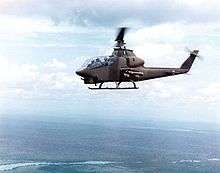
U.S. military
By June 1967, the first AH-1G HueyCobras had been delivered. Originally designated as UH-1H, the "A" for attack designation was soon adopted and when the improved UH-1D became the UH-1H, the HueyCobra became the AH-1G. The AH-1 was initially considered a variant of the H-1 line, resulting in the G series letter.[13]
The first six AH-1s arrived at Bien Hoa Air Base, South Vietnam on 30 August 1967 for combat testing by the U.S. Army Cobra New Equipment Training Team.[14]:11 They made their first combat kill on 4 September, sinking a sampan and killing four Viet Cong.[14]:11 The first AH-1 unit, the 334th Assault Helicopter Company became operational on 6 October 1967. Cobras were in use by the Army until the U.S. withdrawal from South Vietnam in 1973. Cobras provided fire support for ground forces, escorted transport helicopters and other roles, including aerial rocket artillery (ARA) battalions in the two Airmobile divisions. They also formed "hunter killer" teams by pairing with OH-6A scout helicopters. A team featured one OH-6 flying slow and low to find enemy forces. If the OH-6 drew fire, the Cobra could strike at the then revealed enemy.[7] On 12 September 1968, Capt. Ronald Fogleman was flying an F-100 Super Sabre when the aircraft was shot down and he ejected 200 miles north of Bien Hoa. Fogleman became the only pilot to be rescued by holding on to an Army AH-1G's deployed gun-panel door.[15] Bell built 1,116 AH-1Gs for the U.S. Army between 1967 and 1973, and the Cobras chalked up over a million operational hours in Vietnam;[6] the number of Cobras in service peaked at 1,081.[16] Out of nearly 1,110 AH-1s delivered from 1967 to 1973 approximately 300 were lost to combat and accidents during the war.[7][17] The U.S. Marine Corps used AH-1G Cobras in Vietnam for a short time before acquiring twin-engine AH-1J Cobras.[13]
AH-1T Cobras were deployed for Operation Urgent Fury, the invasion of Grenada in 1983. Flying close-support and helicopter escort missions, two of the four available were lost to anti-aircraft fire while attacking Fort Frederick. Army Cobras participated in Operation Just Cause, the U.S. invasion of Panama in 1989.[7]
During Operations Desert Shield and Desert Storm in the Gulf War (1990–91), the Cobras and SuperCobras deployed in a support role. The USMC deployed 91 AH-1W SuperCobras and the US Army 140 AH-1 Cobras of various models; these were operated from forward, dispersed desert bases. Three AH-1s were lost in accidents during fighting and afterward. Cobras destroyed many Iraqi armored vehicles and various targets in the fighting.[7]
Army Cobras provided support for the US humanitarian intervention during Operation Restore Hope in Somalia in 1993. They were also employed during the US invasion of Haiti in 1994. US Cobras were also used in operations later in the 1990s.[7]
The U.S. Army phased out the AH-1 during the 1990s and retired the AH-1 from active service in March 1999, offering them to NATO allies.[6][18] The Army retired the AH-1 from reserves in September 2001. The retired AH-1s have been passed to other nations and to the USDA Forest Service.[6] The AH-1 continues to be in service with the US Marine Corps, which operates the twin-engine AH-1W SuperCobra and AH-1Z Viper.
Israel
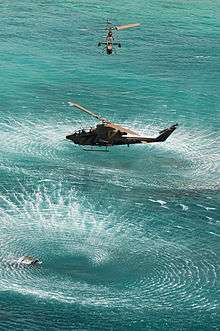
The Israeli Air Force named its Cobras as the "Tzefa" (Hebrew: צפע, for Viper).[19] Since the mid-1970s Lebanon has been Israel's most active front; IAF Cobras had been fighting there for more than 20 years.
Cobra helicopters were also used widely by the Israeli Air Force in the 1982 Lebanon War to destroy Syrian armor and fortification. IAF Cobras destroyed dozens of Syrian ground vehicles. The Cobras were also used in major operations against Hezbollah in Operations "Accountability" and "Grapes of Wrath" in southern Lebanon.
Israel retired its fleet of 33 AH-1 Cobras in late 2013 due to budget cuts. The attack helicopter role was taken up entirely by the squadrons of Israeli AH-64 Apache helicopters, and the fleet of unmanned aerial vehicles (UAVs) took over the role of patrolling combat zones. The Cobra fleet was older than the Apaches which contributed to some fatal crashes. The Cobras were more expensive to maintain than UAVs and their use exposed pilots to attacks from man-portable air-defense systems operated by guerrilla groups.[20] In late 2014, Israel transferred 16 Cobras to the Royal Jordanian Air Force to add to their existing fleet for border security in response to threats posed by Islamic State militants or other insurgent groups.[21]
Japan
Japan manufactured 89 AH-1S Cobras under license by Fuji Heavy Industries from 1984 to 2000.[22] The type is used by the Japan Ground Self-Defense Force, and are Step 3 models, which are roughly the equivalent to the U.S. Army's AH-1Fs. The engine is the T53-K-703 turboshaft, which Kawasaki Heavy Industries produced under license.[7]
Jordan
Jordan obtained 24 AH-1Fs in the late 1980s, and in 2001 obtained nine additional ex-US Army Cobras. In 2010 Jordan transferred 16 AH-1F helicopters to Pakistan, under a US-sponsored support program that provided Islamabad with 40 AH-1 refurbished helicopters.[23]
In late 2014, Israel transferred 16 Cobras to the Royal Jordanian Air Force to add to their existing fleet for border security in response to threats posed by Islamic State militants or other insurgent groups.
The Royal Jordanian Air Force has at least one squadron of Cobras currently in service, and is supposed to have used them in combat in Iraq and Syria.
Turkey
Turkey bought ten AH-1Ws in the early 1990s, and supplemented them with 32 ex-US Army Cobras. The US Army Cobras included some TAH-1P trainers and the rest were brought up to AH-1F version. Turkish Cobras have seen combat in operations against Kurdish insurgents near the Iraqi border. Some Cobras have been lost in these operations.[23][24]
Pakistan
Pakistan was supplied with 20 AH-1S gunships by the U.S. from 1984 to 1986,[25] these were later upgraded with the C-NITE thermal imaging package.[26] Pakistan Army Aviation first used Cobra in Somalia during the United Nations Operation in Somalia II where one squadron was sent in 1994.[27] Later Pakistani Cobras saw action in Sierra Leone.[28][29]
Pakistan had 35 AH-1F helicopters in use in 2013.[30] Maintaining these aircraft has been difficult, but possible through commercial channels. Additionally, the U.S. Government provided $750,000 through 2013 to update Pakistan Army Aviation's existing AH-1F/S Cobra fleet.[31] Turkey has also supplied spare parts of Cobra helicopters to Pakistan free of cost.[32] Pakistan lost three aircraft in the past decade.[33][34][35]
Pakistan repeatedly sought the Bell AH-1 SuperCobra from the U.S. to supplement and replace its current AH-1 Cobras.[26] Attempts to acquire the AH-1Z Viper or AH-64 Apache from the U.S. were rejected, so Pakistan turned to buying other foreign attack helicopters. Possible candidates have included the Turkish T129, the Chinese CAIC Z-10, and the Russian Mi-35 Hind.[36] In November 2014, Russia approved the sale of Mi-35M helicopters to Pakistan.[37] In April 2015, China delivered three Z-10s to Pakistan.[38] During the same month, the U.S. State Department approved the sale of 15 AH-1Zs and associated equipment to Pakistan.[39] As of October 2017, the T129 was also the contender.[40]
Philippines
The Jordanian government offered to provide up to four surplus AH-1S Cobra/Tzefa attack helicopters to the Philippines for fighting terrorists. But the offer was reduced to two units, which the Philippine government accepted.[41][42]
On 26 November 2019, an Antonov An-124 airlifter carrying the two Bell AH-1S Cobras from Jordan arrived in Clark International Airport / Clark Air Base. This was confirmed by the PAF's Commanding General Lt. Gen. Rozzano Briguez during his speech as part of the 15th Strike Wing's founding anniversary celebrations. The helicopters are said to be painted in light grey similar to the paint scheme of the PAF's AgustaWestland AW-109E armed helicopters.[43]
U.S. firefighting
In 2003, the U.S. Forest Service acquired 25 retired AH-1Fs from the U.S. Army.[6] These have been designated Bell 209 and are being converted into Firewatch Cobras with infrared and low light sensors and systems for real time fire monitoring.[44][45]
The Florida Division of Forestry also acquired three AH-1Ps from the U.S. Army. These are called Bell 209 "Firesnakes" and are equipped to carry a water/fire retardant system.[6][46]
Variants

Single-engine
- Bell 209
- Original AH-1G prototype with retractable skid landing gear. This model number is also used by the FAA for the civilian registration of former U.S. Army AH-1s used in firefighting service.
- AH-1G HueyCobra
- Initial 1966 production model gunship for the US Army, with one 1,400 shp (1,000 kW) Avco Lycoming T53-13 turboshaft.
- JAH-1G HueyCobra
- One helicopter for armament testing including Hellfire missiles and multi-barrel cannon.[47]
- TH-1G HueyCobra
- Two-seat dual-control trainer.[47]
- Z.14 HueyCobra
- The Spanish Navy purchased eight new-build AH-1Gs, designating the type the "Z-14". These were equipped with the M35 20 mm cannon system, and were used to support coastal patrol boats. Four of these were lost in accidents. The remaining helicopters were retired in 1985 with three sent back to the US, and one kept in storage in Spain.[47][48]
- YAH-1Q
- Eight AH-1Gs with XM26 Telescopic Sight Unit (TSU) and two M56 TOW 4-pack launchers.[7]
- AH-1Q HueyCobra
- Equipped with the M65 TOW/Cobra missile subsystem, M65 Telescopic Sight Unit (TSU), and M73 Reflex sight. All future versions will be equipped with the TSU and be equipped to fire the TOW missile subsystem.
- YAH-1R
- AH-1G powered by a T53-L-703 engine without TOW system.[7]
- YAH-1S
- AH-1Q upgrade and TOW system.[7]
- AH-1S
- The baseline AH-1S is an AH-1Q upgraded with a 1,800 shp (1,300 kW) T53-L-703 turboshaft engine. The AH-1S is also referred to as the "Improved AH-1S", "AH-1S Modified", or "AH-1S(MOD)" prior to 1988. (Prior to 1988, all upgraded aircraft were referred to as variants of the AH-1S.)[7]
- QAH-1S
- A target drone conversion of the AH-1S by Bell-Bristol Aerospace under a joint US and Canada development program started in 1994. Honeywell further modified the QAH-1S into the Hokum-X by installing systems and hardware to allow it to simulate the Russian Kamov Ka-50 attack helicopter. Three Hokum-Xs were completed from 1998–2001.[49][50]
- AH-1P
- 100 production aircraft with composite rotors, flat plate glass cockpit, and improved cockpit layout for nap-of-earth (NOE) flight. The AH-1P is also referred to as the "Production AH-1S", or "AH-1S(PROD)" prior to 1988. These improvements are considered Step 1 of the AH-1S upgrade program.[7]
- AH-1E
- 98 production aircraft with the Enhanced Cobra Armament System (ECAS) featuring the M97A1 armament subsystem with a three-barreled M197 20 mm cannon. The AH-1E is also referred to as the "Upgunned AH-1S", or "AH-1S(ECAS)" prior to 1988. These improvements are considered Step 2 of the AH-1S upgrade program.[7] AH-1E aircraft included the M147 Rocket Management Subsystem (RMS) to fire 2.75-inch (70 mm) rockets.[51]
- AH-1F
- 143 production aircraft and 387 converted AH-1G Cobras. The AH-1F incorporates all Step 1 and 2 upgrades to the AH-1S. It also featured Step 3 upgrades: a head-up display, a laser rangefinder, an infrared jammer mounted above the engine exhaust, and an infrared suppressing engine exhaust system, and the M143 Air Data Subsystem (ADS). The AH-1F is also referred to as the "Modernized AH-1S", "AH-1S Modernized Cobra", or "AH-1S(MC)" prior to 1988.[52]
- Model 249
- Experimental demonstrator version fitted with a four-bladed rotor system, an uprated engine and experimental equipment, including Hellfire missiles.[53]
- Bell 309 KingCobra
- Experimental all-weather version based on the AH-1G single-engine and AH-1J twin-engine designs.[54] Two Bell 309s were produced; the first was powered by a PW&C T400-CP-400 Twin-Pac engine set and the second was powered by a Lycoming T-55-L-7C engine.[55]
Twin-engine
Operators
A small number of former military helicopters are operated by civil organizations for display and demonstration, for example by Red Bull.[56]
.png)
- Bahrain Air Force[30]
.jpg)
- Philippine Air Force[59]( 2 AH-1F variant )
- Turkish Army[30]
Former Operators
.jpg)
Aircraft on display
Specifications (AH-1G HueyCobra)
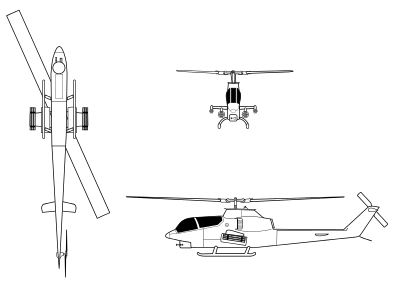
Data from The Illustrated Encyclopedia of the World's Modern Military Aircraft[69], Bell AH-1 Cobra[70], Modern Fighting Aircraft : AH-1 Cobra[71]
General characteristics
- Crew: 2: one pilot, one co-pilot/gunner (CPG)
- Length: 53 ft (16 m) including rotors
- Fuselage length: 44 ft 5 in (13.5 m)
- Width: 10 ft 4 in (3.15 m) stub wings
- Height: 13 ft 6 in (4.11 m)
- Empty weight: 5,810 lb (2,635 kg)
- Max takeoff weight: 9,500 lb (4,309 kg)
- Powerplant: 1 × Lycoming T53-L-13 turboshaft, 1,100 hp (820 kW)
- Main rotor diameter: 44 ft 0 in (13.4 m)
- Main rotor area: 1,520 sq ft (141 m2)
- Blade section: NACA 0009.3 mod[72]
Performance
- Maximum speed: 149 kn (171 mph, 276 km/h)
- Never exceed speed: 190 kn (220 mph, 350 km/h)
- Range: 310 nmi (360 mi, 570 km)
- Service ceiling: 11,400 ft (3,500 m)
- Rate of climb: 1,230 ft/min (6.2 m/s)
Armament
- 2 × 7.62 mm (0.308 in) multi-barrel Miniguns, or 2 × M129 40 mm grenade launchers, or one of each, in the M28 turret. (When one of each was mounted, the minigun was mounted on the right side of the turret, due to feed requirements.)
- 2.75 in (70 mm) rockets – 7 rockets mounted in the M158 launcher or 19 rockets in the M200 launcher
- M18 7.62 mm Minigun pod or XM35 armament subsystem with XM195 20 mm cannon
Notable appearances in media
See also
- U.S. Helicopter Armament Subsystems, AH-1 Cobra
Related development
- Bell 207 Sioux Scout
- Bell 309 KingCobra
- Bell AH-1 SuperCobra
- Bell AH-1Z Viper
- Bell UH-1 Iroquois
- Bell YAH-63
Aircraft of comparable role, configuration and era
Related lists
References
Notes
- "Military aircraft prices". 14 September 2000. Archived from the original on 14 September 2000.
- Wheeler 1987, pp. 62–64.
- Wheeler 1987, pp. 57–62, 64–65.
- Wheeler 1987, pp. 60–61.
- Verier 1990, pp. 12–17.
- Donald and March 2004.
- Bishop 2006.
- Verier 1990, pp. 30–31.
- Verier 1990, p. 44.
- Verier 1990, pp. 86–88.
- RD&A, Sect 135 – Army Historical Summary: FY74
- Verier 1990, pp. 57, 59–61.
- Donald 2004, p. 166.
- Bernstein, Jonathan (2003). US Army AH-1 Cobra Units in Vietnam. Osprey Publishing. ISBN 978-1841766065.
- F-100 Super Sabre Flew Most Missions in Vietnam – Defensemedianetwork.com, 12 September 2013
- Webster & Pedrotty et al. "Historical and Architectural Overview of Military Aircraft Hangars" pp. 5–23 United States Air Force Air Combat Command, September 1999.
- Verier 1990, p. 35.
- Army retires Cobras from active force Archived 7 November 2015 at the Wayback Machine. U.S. Army, 31 March 1999.
- Walter J. Boyne (January 2013). "Airpower Classics" (PDF). Air Force Magazine. Air Force Association: 84.
- Drones gain ground in Israel after Cobra helicopters cut – Reuters.com, 28 May 2014
- Israel gives Jordan helicopters for border security – U.S. source – Reuters.com, 23 July 2015
- "Apache wins Japan deal". Flight International, 4 September 2001.
- "[2.0] Second-Generation Cobras". www.airvectors.net.
- Erin Cunningham (14 May 2016). The Washington Post (ed.). "Kurdish militants reportedly shoot down Turkish security forces helicopter".
- "SIPRI". armstrade.sipri.org. Retrieved 15 April 2013.
- "Pakistan Wants More Helicopter Gunships". 2 January 2010.
- "Army Aviation". www.pakistanarmy.gov.pk. Archived from the original on 6 September 2017. Retrieved 13 September 2017.
- "Army Aviation". www.pakistanarmy.gov.pk. Archived from the original on 6 September 2017. Retrieved 13 September 2017.
- "US transfers Cobra helicopters to Pakistan". GEO News. 16 March 2010. Archived from the original on 29 October 2013.
- "World Air Forces 2013" (PDF). Flightglobal Insight. 2013.
- "US delivers Cobra gunships to Pakistan". The Nation (Pakistan). 17 March 2010. Archived from the original on 2 November 2013.
- "Turkey to provide Cobra spare parts free of charge". Daily Times (Pakistan). 25 January 2010. Archived from the original on 2 November 2013.
- "Pakistan Army". Archived from the original on 31 October 2013. Retrieved 13 June 2013.
- "Top Pakistan army officer dies in helicopter crash". Global Times. 11 February 2010. Archived from the original on 1 November 2013.
- "Pakistani Army's AH-1 Cobra helicopter crashes injuring pilots". Voice of Russia. 28 October 2013. Retrieved 30 October 2013.
- "Pakistani Cobra Crash Further Stresses Tired Fleet" – Defensenews.com, 27 June 2014
- Pakistan Wins Approval To Purchase Mi-35 Helo – Defensenews.com, 13 November 2014
- "Chinese 'Thunderbolt' helicopters may replace American Cobras in Pakistan – The Express Tribune". 3 April 2015.
- News, Defense (8 August 2017). "pakistan-ah-1z-deal-dsca-hellfire-taliban-tribal-area-waziristan". Defense News.
- Dawn (23 October 2017). "Shahid Khaqan Abbasi becomes Pakistan's first PM to fly military helicopter". Dawn.
- https://www.phdefenseresource.com/2019/11/transfer-of-ah-1f-cobra-attack.html
- https://globalnation.inquirer.net/167203/jordan-donates-2-attack-helicopters
- https://www.phdefenseresource.com/2019/11/transfer-of-ah-1f-cobra-attack.html
- Firewatch Helicopter page. U.S. Forest Service, 2004. Archived 27 December 2008 at the Wayback Machine
- "Shasta-Trinity National Forest – Home" (PDF). fs.fed.us. Retrieved 1 April 2015.
- Stephens, Ernie. "Recycling helicopters from military service to public service." Rotor & Wing, November 2008. Retrieved on 12 October 2009.
- Donald 1997, p. 112.
- Goebel, Greg. International Cobra Sales Archived 30 November 2009 at the Wayback Machine. Vectorsite.net, 1 December 2008.
- "Bristol Aerospace Hokum-X". Jane's Unmanned Aerial Vehicles and Targets, Jane's Information Group, 2006. (subscription article dated 14 December 2006)
- "Honeywell QAH-1S". Jane's Unmanned Aerial Vehicles and Targets, Jane's Information Group, 2006. (subscription article dated 3 February 2006)
- McGowen, Stanley S. (2005). Helicopters: An Illustrated History of Their Impact. ABC-CLIO. p. 159. ISBN 978-1-85109-468-4.
- Bishop 2006, p. 11.
- Verier 1990, pp. 72–76.
- Verier 1990, p. 57.
- Richardson 1987, pp. 8–9.
- "Bell Cobra TAH-1F". flyingbulls.at
- Cherisey, de, Erwan (30 June 2017). "Kenya takes delivery of AH-1 Cobras". IHS Jane's 360. Paris. Archived from the original on 17 July 2017. Retrieved 17 July 2017.
- Binnie, Jeremy (13 December 2017). "Kenyan displays new AH-1 Cobras". IHS Jane's 360. Archived from the original on 18 December 2017. Retrieved 18 December 2017.
- "M113 APCs and AH-1F Cobras donated by Jordan to the Philippines". Army Recognition. 24 April 2018. Archived from the original on 5 May 2018. Retrieved 5 May 2018.
- "South Korean Army Bell-AH-1S". Demand media. Retrieved 12 February 2013.
- "B-209 "FireSnake" helicopter". floridaforestservice.com. Archived from the original on 17 July 2012. Retrieved 12 February 2013.
- "USFS Fire Watch program". firewatchcobra.com. Archived from the original on 31 August 2013. Retrieved 12 February 2013.
- "USFS Bell AH-1F Cobra (209)". Demand media. Retrieved 12 February 2013.
- "Israel halts AH-1 sales talks with Nigeria". flightglobal.com. Retrieved 25 January 2015.
- "AH-1G Cobra in Arma Aerea de la Armada Española". Helis.com.
- "World Military Aircraft Inventory". 2014 Aerospace Source Book. Aviation Week and Space Technology, January 2014.
- "Cobra Gold: The US Army's Smart Retirement Program". defenseindustrydaily.com. Retrieved 12 February 2013.
- "HeliHub.com Washington State retires AH-1 fleet from firefighting duties, adds two UH-1s". helihub.com.
- Gunston, Bill (1978). The Illustrated Encyclopedia of the World's Modern Military Aircraft. New York: Crescent Books. p. 205. ISBN 978-0-517-22477-9.
- Verier, Mike (1990). Bell AH-1 Cobra. London: Osprey. p. 184. ISBN 0-85045-934-6.
- Richardson, Doug (1987). AH-1 Cobra. New York: Prentice Hall. p. appendix. ISBN 0-13-020751-9.
- Lednicer, David. "The Incomplete Guide to Airfoil Usage". m-selig.ae.illinois.edu. Retrieved 16 April 2019.
Bibliography
- Bernstein, Jonathan. US Army AH-1 Cobra Units in Vietnam (Osprey Combat Aircraft #41). Oxford, UK: Osprey Publishing Limited, 2003. ISBN 978-1-84176-606-5.
- Bishop, Chris. Huey Cobra Gunships. Oxford, UK: Osprey Publishing Limited, 2006. ISBN 1-84176-984-3.
- Donald, David. The Complete Encyclopedia of World Aircraft. Barnes & Nobel Books, 1997. ISBN 0-7607-0592-5.
- Donald, David and March, Daniel (eds). Modern Battlefield Warplanes. AIRtime Publishing Inc, 2004. ISBN 1-880588-76-5.
- Gunston, B. and Michael Spick. Modern Fighting Helicopters, pp. 104–105. New York: Crescent Books, 1986. ISBN 0-517-61349-2.
- International Air Power Review, Volume 12. AIRtime Publishing, 2004. ISBN 1-880588-77-3.
- Nolan, Keith W. Into Laos: Dewey Canyon II/Lam Son 719, Vietnam 1971. Presidio Press, 1986. ISBN 0-89141-247-6.
- Wheeler, Howard A. Attack Helicopters, A History of Rotary-Wing Combat Aircraft. The Nautical and Aviation Publishing Company, 1987. ISBN 0-933852-52-5.
External links
| Wikimedia Commons has media related to AH-1 Cobra. |
